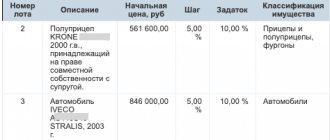What is legal invalidity
The area of concluding transactions relates to civil law: this means that both parties must perform their actions in the designated legal field (strictly within the framework of current legislation and in accordance with the requirements of regulations).
What are the relationships between fictitious, imaginary and sham transactions ?
As for transactions, they are characterized by 4 significant categories that determine their legal existence:
- parties (participants, subjects of the transaction);
- the external expression of the will of the participants is the subjective area of the transaction;
- transaction form;
- conditions (content, subject of the transaction).
Any non-compliance with the law in at least one of these elements will invalidate the transaction.
On what grounds can a transaction be declared invalid ?
Position of the bankruptcy trustee
Briefly:
Transaction amount. The car was alienated a year before bankruptcy, while the contract price was 350 thousand rubles - the transaction was clearly not at the market price. To support his arguments, the manager attached screenshots from thematic sites, and there the car is sold in the range from 2 to 3.5 million. Compare with 350 thousand - the difference is noticeable.
No payment. Based on bank statements for Rive Gauche accounts at VTB Bank, 350 thousand were not received on the specified date. At the same time, the registration of the car to the buyer took place. There is an unequal deal: Valentina received the car, but did not pay the money.
Affiliation of persons. The deal was concluded with Alexander’s wife - where else could one find a more interested person?
The pleading part: Valentina must return the car to the debtor, and Alexander must receive a ticket for a subsidy in full!
Types of invalid transactions
The possibilities of breaking the law when concluding transactions are quite extensive, this determines the classification of their invalidity. Depending on the order in which their invalidity is revealed, they can be:
- disputable - their legal inconsistency will have to be proven during the judicial procedure;
- void - showing their invalidity immediately upon conclusion.
Most often, as practice shows, imaginary and feigned transactions are made. They are considered void – invalid immediately from the moment they are committed. During these transactions, the expression of will is violated - the actual actions of the parties do not correspond to the real will of the parties.
What are the accounting, auditing and legal approaches when establishing criteria for recognizing transactions as imaginary and sham ?
pros
First instance
Despite the past meetings, this was still only the first instance. We still had the opportunity to correct the client’s position and add new evidence.
Task type
Challenging transactions assumes that the burden of proof lies with the bankruptcy court. Our task is simply to refute his words. And breaking, as they say, is not building.
Responsible client
Although the deal was disputed between the organization and the director’s wife, in fact it was our client who was interested in the outcome of this trial. And Alexander is a very responsible person who saved all the documents and was deep in the topic.
Experience
Challenging transactions and, conversely, protecting against challenge is not a new direction for us.
Features of an imaginary transaction
Civil Code of the Russian Federation in Part 1 of Art. 170 calls an imaginary transaction, which is concluded without any incentive to create real legal results, solely “for show,” and both parties are well aware of this. This is by no means an aimless transaction, it’s just that its purpose does not correspond to the stated one, it is hidden from external observers because it is illegal.
FOR EXAMPLE . The company is facing inevitable bankruptcy, and it “rewrites” part of its assets to another person. In this case, the property does not actually change hands at all, because the real purpose of the transaction is precisely to preserve it. After all, in the event of bankruptcy, assets will be sold for debts.
Another common example of a sham transaction is disguising a bribe. A “sale” of valuable property is formalized, only in reality the buyer does not pay any money agreed upon in the terms of the transaction.
How to distinguish an imaginary deal
Imaginary transactions have features that characterize them, in contrast to “normal” legal transactions, as well as from other types of invalid ones. Some of the features will certainly appear, and some may or may not occur.
Characteristic features of imaginary transactions:
- There is a violation of the will, but the form is strictly observed and even excessively (for example, documents that do not require confirmation are certified by a notary, things that can be discussed orally are drawn up in writing, etc.).
- After the transaction is concluded, its terms are not fulfilled or this occurs only in relation to part of the content. The transaction is carried out only on paper.
- Both parties do not intend to fulfill the terms of the transaction, having agreed on this before its completion.
- The real purpose of concluding such a transaction is contrary to legal norms.
Indirect features may also indicate that the transaction is sham:
- dependent, close or even family ties between the parties to the transaction;
- coincidence of legal addresses of the parties-legal entities;
- some persons or the entire composition of the founders of the organizations concluding the transaction are the same;
- For a certain period of time, no real actions occur that will inevitably cause the terms of the transaction to be fulfilled.
FOR EXAMPLE. An imaginary transaction was concluded for the purchase and sale of residential real estate. If we consider its validity in court, they will ask who is currently registered or living in the alienated property - the buyer or still the seller or their representatives. The court will also find out whether contracts with housing and communal services have been renegotiated, who pays for utilities, etc. The question of the circumstances surrounding the transfer of money will also be raised.
Consequences of recognizing the invalidity of an imaginary transaction
Since the parties did not actually transfer anything to each other during the imaginary transaction, they should not return anything. Having proved the legal inconsistency of the transaction, the court will only cancel the transaction itself. And what this cancellation will lead to does not matter, since the legislative “status quo” must be restored.
FOR EXAMPLE . The citizen was sued, demanding payment of the debt. Knowing that he will be forced to fulfill the demand, wanting to avoid having his apartment seized, he enters into a deal to “sell” it to a person he trusts. In fact, he continues to live in an apartment that does not belong to him only formally. The court proves that the deal is sham. What's changing? The ownership that has been changed is returned. Now the creditor will be able to recover his funds by seizing and selling the apartment at auction, which will be carried out by the enforcement service. Please note that these consequences will occur if the apartment was sold after the creditor went to court. In a situation where the debtor has “insured himself” in advance, it will no longer be possible to prove anything, especially if a trusted person or relative has already resold the apartment legally.
IMPORTANT! If the court determines that there were no consequences for the transaction, it will be declared imaginary, regardless of whether proper registration has been completed or whether there are deviations from the norm (for example, the transaction has not yet been registered).
The imaginary deal was declared invalid, but what will happen to its participants, besides the return of the original rights? For those who made a sham transaction, liability may arise if additional charges are brought against them, for example, a police report for fraud.
Minuses
Inequality of the transaction
No matter what condition the Range Rover was in, it certainly wasn’t worth 350 thousand. Even for a million. The grounds for challenge were very real.
Transaction in the pre-bankruptcy period
In order to challenge a transaction made within 12 months before the bankruptcy petition is accepted, it is enough to prove that it was made at a price below the market.
Availability of a disputed transaction
A similar transaction on the same grounds and between the same persons only with a different car has already been challenged by the court in a parallel case. In any case, the court has already formed its opinion regarding the situation with corporate cars. We had to work with him.
Affiliation of persons
In this case, it didn’t matter much, but it certainly didn’t make the situation any easier. From all of the above, we characterized the situation as “the patient is more dead than alive,” but we would not be “Igumnov Group” if we had not tried to squeeze out the maximum possible for victory.
Sham transactions and the nuances of their invalidity
A sham transaction is sometimes called a type of sham transaction. Part 2 art. 170 of the Civil Code of the Russian Federation thus characterizes a completed transaction, designed to replace in the eyes of the law another transaction, perhaps on completely different terms. A sham transaction always has two components:
- cover deal – one that is intended to play the “main role”;
- the one being covered up is the one from which the parties actually want to cause legal consequences.
FOR EXAMPLE.
1. One citizen buys a car from another. To simplify paperwork and reduce taxes, instead of completing a purchase and sale, as should be required by law, a transfer by power of attorney is executed. The money for the car is actually transferred to the seller.
2. A house is for sale, the seller and the buyer have agreed on a price of 950,000 rubles. A purchase and sale agreement is drawn up, which specifies a price of 300,000 rubles in order to reduce income tax.
The main differences between a sham transaction and an imaginary one:
- participants plan legal consequences, but not those guaranteed by the concluded deal;
- Only the pretended part of the transaction is invalid, and the true part will remain legally recognized if it complies with the law.
Legal consequences of invalidity of a sham transaction
If it is possible to prove that the transaction is fictitious, the consequences will be different from those caused by the cancellation of the fictitious one. In a sham transaction there is a share of true legal relations, which cannot be canceled if it is legal. Thus, the part of the deal that does not correspond to the real state of affairs will be canceled, and the very deal that the parties tried to disguise will come into force in its place.
Using the examples given above, let us consider what consequences will occur if these transactions are declared invalid:
- The new owner of the car will not actually be its owner; he cannot completely dispose of the car at his own discretion. After the expiration of the power of attorney, if it is not renewed, which the true owner has every right to do, the “buyer” of the car will completely lose ownership of it.
- If such a transaction is declared invalid, the buyer will be returned only the money indicated in the text of the contract - 300,000 rubles, even if in fact he transferred the entire 950,000 rubles to the seller. The house will remain the property of the seller.
Evidence of a fraudulent transaction
This is a particularly difficult task. Most often, the party affected by a sham transaction is the tax authorities. And since they are not participants in the transaction, they do not have the right to sue the real participants. But if the transaction was concluded between organizations covering up their actual financial affairs, tax authorities may require an audit and bring the violators to justice.
FOR EXAMPLE. The company purchased equipment from suppliers, indicating in the documents a price that was clearly below the market price. Thus, it is not a purchase or sale, but an actual donation of most of the goods. Donation between legal entities is impossible, so it will not be possible to restore the true transaction. The company will have to either return the goods to the suppliers, adding compensation, or pay the real price for it (thereby “without offending” the tax authorities).
Who has the right to claim
Some courts do not recognize the creditor as a proper plaintiff and refuse to file a claim to challenge the transaction out of competition.
Their logic is as follows. Clause 3 of Article 166 of the Civil Code of the Russian Federation states: “The requirement to apply the consequences of the invalidity of a void transaction has the right to be presented by a party to the transaction, and in cases provided for by law, also by another person.” The creditor is neither a party to the transaction nor “another person”, since the law does not have a direct rule that would give the creditor the right to challenge the transaction between its debtor and a third party.
This approach is wrong. Such courts do not take into account the explanations given in paragraph 78 of the Resolution of the Plenum of the Supreme Court of the Russian Federation dated June 23, 2015 N 25 “On the application by courts of certain provisions of Section I of Part One of the Civil Code of the Russian Federation,” which says: “Based on the systemic interpretation of paragraph 1 of Article 1, paragraph 3 of Article 166 and paragraph 2 of Article 168 of the Civil Code of the Russian Federation, the claim of a person who is not a party to a void transaction for the application of the consequences of its invalidity may also be satisfied if civil legislation does not establish another method of protecting the rights of this person and its protection is possible only by applying the consequences of the invalidity of the void transaction transactions."
A creditor who has lost the opportunity to foreclose on the debtor’s property cannot protect his right except through a lawsuit aimed at returning the seized property to the debtor. Therefore, he has the right to challenge the transaction between his debtor and a third party out of competition.
Finish line
A complaint to the cassation is a predictable move by the manager. Considering the passions in the appeal, the competition thought that his chips would go through there too. But no. In response to all attempts to draw attention to the insight that had come about the case, the judge asked one simple question: “My dear, are you sure that you have not overestimated the powers of the cassation court?” — to which the contestant nodded in agreement, but continued to stick to his guns.
Despite these attempts, on February 28, 2021, Valentina and Alexander officially got the opportunity to keep the car.
New battlefield
As expected, the bankruptcy went to appeal.
To be honest, watching the work of our opponents in the first instance, we exhaled a little: since he did not provide significant evidence there, then his chances of winning were lower. At least if he didn’t change tactics - and there was no way to count on that.
Oh, how wrong we were.
After the failure of the first instance, another representative of the bankruptcy court began to appeal. And this was a real fighter, ready to tear us to shreds, bypassing all decency.
With the supply of fresh blood and an updated composition of the court, we received the following blows:
- Oops! Since when did Range Rovers sell for that kind of money?
- Have you proven that the deal is not imaginary?
- Where did you even get the million?
Do you understand what happened? The appeal began to assert grounds that were not mentioned at all in the first instance. Don't believe me? Just leave your email and look at the judicial acts of the first instance - the phrase “imaginary deal” is never mentioned there.
When I began to explain to the court that this was not even discussed in the first instance and therefore these arguments cannot now be considered, the bankruptcy judge, realizing in whose favor the court was leaning, shook his mane: “What are you saying, what are you saying, of course!” .
Moreover, the manager immediately decided that he had doubts that the 350 and 650 thousand received from the cash register to the current account were really related to the sale of the car: “The purpose of payment indicated “Trade proceeds.” And given that the debtor company was engaged in alcoholic beverages, these amounts probably came from the sale of goods, and not as payment for a car.”
Do you catch the whole farce?
We are struggling here, figuring out how to beautifully put everything in order and justify it, refer to the applicant’s lack of proof of his position, and the appeal takes and turns the situation 180 degrees.
Now we need to fight back and prove that the deal was not sham. Although this basis was not even stated in the first instance. But we are not used to this, and given that the appeal announced a break for 5 days, there was plenty of time to think and justify our position.








